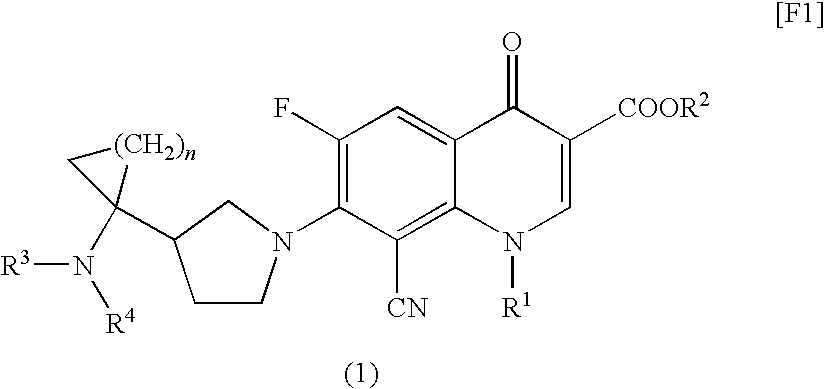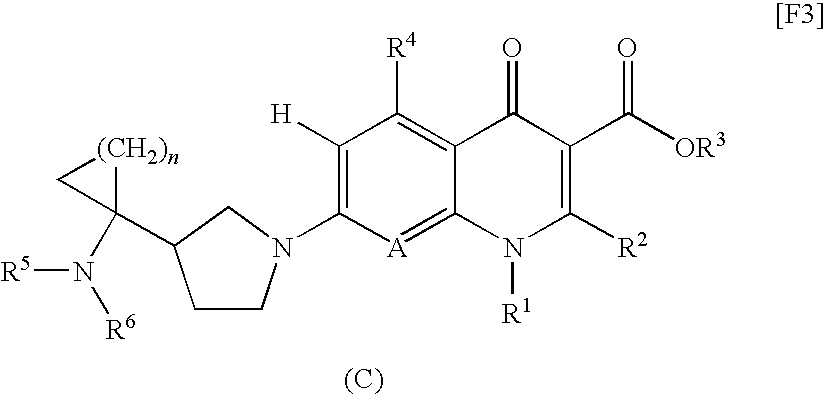8-cyanoquinolonecarboxylic acid derivative
a technology of cyanoquinolone and carboxylic acid, which is applied in the field of quinolone compounds, can solve the problems of difficult use of synthetic antibacterial agents as pharmaceutical drugs or veterinary drugs, and the derivatives of synthetic antibacterial agents have various side effects, and achieve excellent antibacterial activity and high safety
- Summary
- Abstract
- Description
- Claims
- Application Information
AI Technical Summary
Benefits of technology
Problems solved by technology
Method used
Image
Examples
referential example 1
Ethyl 3-acetoxymethyl-2,4,5-trifluorobenzoate
[0083]
[0084]Ethyl 3-methyl-2,4,5-trifluorobenzoate (61.0 g, 279 mmol) was dissolved in benzene (1,000 mL). N-Bromosuccinimide (76.2 g, 428 mmol) and 2,2′-azobisisobutyronitrile (100 mg) were added thereto, and the mixture was refluxed for 3 days. The reaction mixture was left to cool, and the solid matter that precipitated was separated through filtration and washed with benzene. Subsequently, the filtrate and the wash solution were combined. The mixture was concentrated under reduced pressure. The residue was subjected to silica gel chromatography (eluent; n-hexane:ethyl acetate=20:1 to 10:1), to thereby yield a mixture of the starting material and ethyl 3-bromomethyl-2,4,5-trifluorobenzoate (about 1:1, 57.8 g). The mixture was dissolved in DMF (290 mL), and sodium acetate (22.1 g, 269 mmol) was added thereto, followed by stirring for 30 minutes at 90° C. The reaction mixture was left to cool, and ethyl acetate (1,000 mL) was added there...
referential example 2
Ethyl 3-hydroxyiminomethyl-2,4,5-trifluorobenzoate
[0086]
[0087]Ethyl 3-acetoxymethyl-2,4,5-trifluorobenzoate (15.0 g, 54.2 mmol) was dissolved in ethanol (280 mL), and to the resultant solution, 21 wt % sodium ethoxide-ethanol solution (18.9 mL, 54.2 mmol) was added dropwise while cooling with ice. The resultant mixture was stirred at the same temperature for 10 minutes. While cooling with ice, saturated aqueous ammonium chloride (300 mL) was added to the reaction mixture and ethanol was concentrated under reduced pressure. The residual aqueous layer was extracted with ethyl acetate (300 mL×2). The organic layers were combined and washed with saturated brine (500 mL), followed by drying with sodium sulfate anhydrate. After filtration, the filtrate was concentrated under reduced pressure. The residue was dissolved in dichloromethane (50 mL), and while cooling with ice, the resultant solution was added dropwise to a suspension prepared through adding pyridinium dichromate (PDC) (40.2 g...
referential example 3
Ethyl 3-cyano-2,4,5-trifluorobenzoate
[0089]
[0090]Ethyl 3-hydroxyiminomethyl-2,4,5-trifluorobenzoate (5.5 g, 24.0 mmol) was dissolved in trichloroacetonitrile (25 g), and the solution was stirred at 90° C. for 16 hours. The reaction mixture was left to cool, and the solid matter that precipitated was separated through filtration. The filtrate was concentrated under reduced pressure. The residue was subjected to silica gel chromatography (eluent; n-hexane ethyl acetate=10:1), to thereby yield the title compound as a colorless oily substance (3.35 g, 61%).
[0091]1H-NMR (CDCl3) δ ppm: 1.41 (3H, t, J=7.1 Hz), 4.44 (2H, q, J=7.1 Hz), 8.07 (1H, td, J=9.3, 6.5 Hz).
PUM
| Property | Measurement | Unit |
|---|---|---|
| reaction temperature | aaaaa | aaaaa |
| reaction temperature | aaaaa | aaaaa |
| temperature | aaaaa | aaaaa |
Abstract
Description
Claims
Application Information
 Login to View More
Login to View More - R&D Engineer
- R&D Manager
- IP Professional
- Industry Leading Data Capabilities
- Powerful AI technology
- Patent DNA Extraction
Browse by: Latest US Patents, China's latest patents, Technical Efficacy Thesaurus, Application Domain, Technology Topic, Popular Technical Reports.
© 2024 PatSnap. All rights reserved.Legal|Privacy policy|Modern Slavery Act Transparency Statement|Sitemap|About US| Contact US: help@patsnap.com










